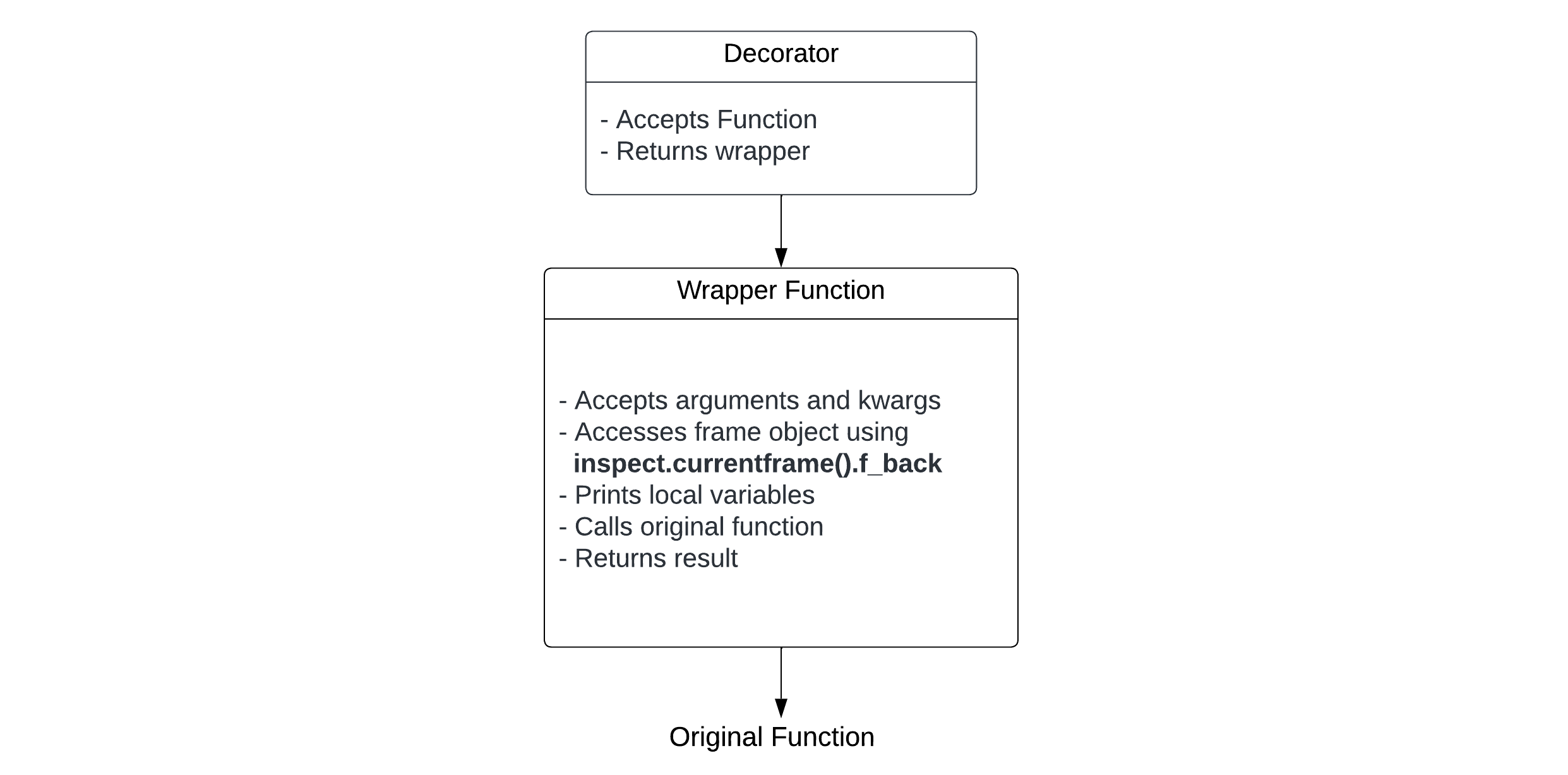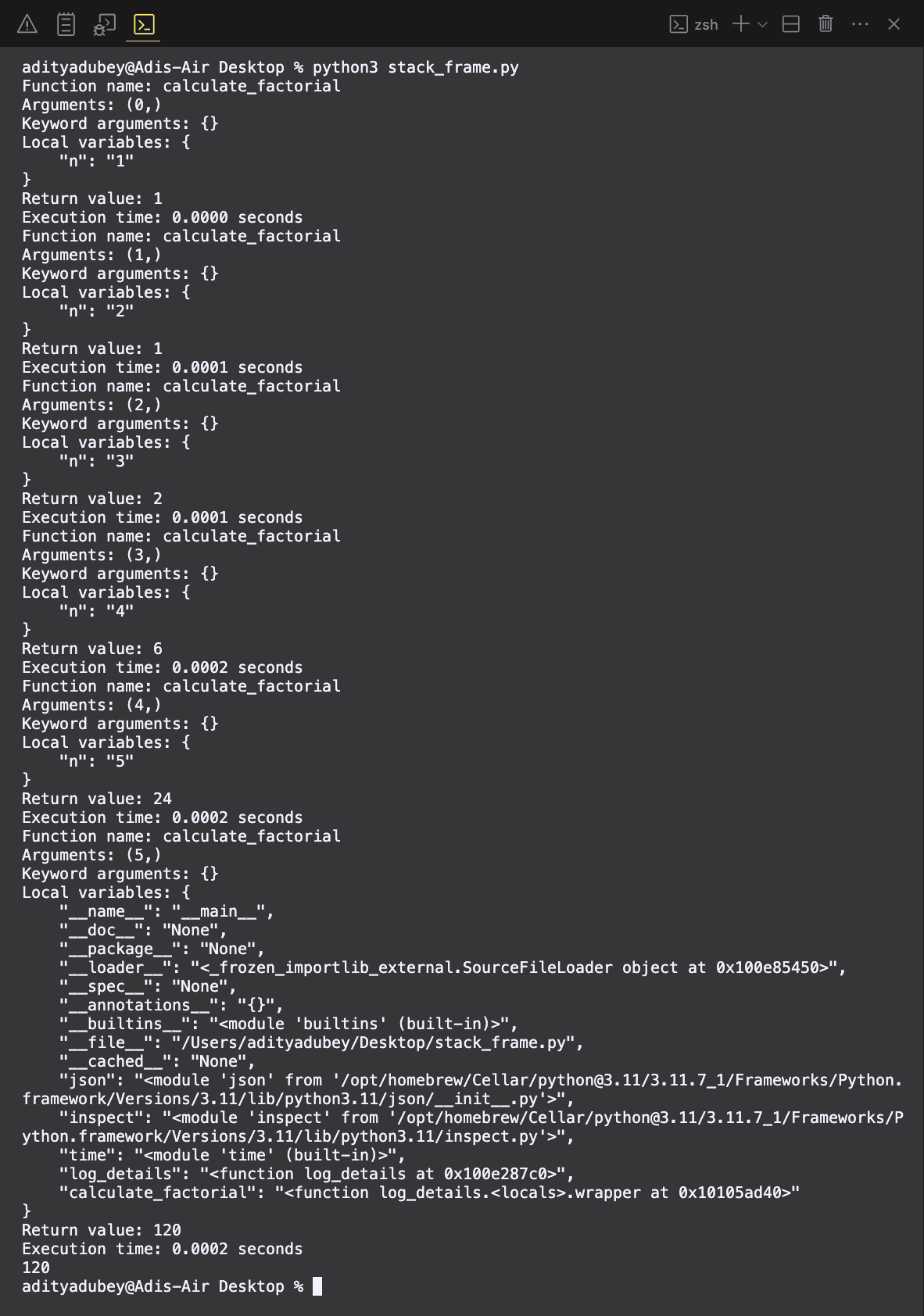Stack Frames in Python: Accessing the frame object using decorator
 Aditya Dubey
Aditya Dubey
Introduction
Understanding memory management is crucial for writing efficient and error-free code in any programming language. In Python, a language known for its simplicity and readability, memory management plays a vital role in the execution of programs. One fundamental aspect of memory management in Python is the concept of stack frames. In this blog post, we'll delve into the intricacies of stack frames, exploring what they are, how they work, and their significance in Python programming.
Understanding Function Calls and Stack Frames:
Prerequisite: Python (v3) Stack Frame Examples
https://www.cs.swarthmore.edu/courses/CS21Labs/f19/docs/cs21-stack-frame-tutorial.pdf
When you call a function in Python, it gets placed on a stack. This stack keeps track of the currently executing functions and their local state. Each entry on the stack is called a "frame."
inspect.currentframe()helps you access the frame of the function where you're currently executing the code.
1. frame = inspect.currentframe()
This line fetches the frame of the current function itself.
In the context of a decorator,
currentframe()would point to the frame of the decorator function (log_detailsin below example).
2. frame = inspect.currentframe().f_back
This line takes the current frame (
currentframe()) and then uses thef_backattribute.f_backrefers to the previous frame on the stack, which is the frame of the function that called the current function.In a decorator scenario,
f_backgives you access to the frame of the function being decorated (the one you want to inspect).
Exploring Stack Frames in Python:
Python, known for its simplicity and readability, implements stack frames to manage function calls and execution context efficiently. The call stack in Python operates on a last-in, first-out (LIFO) basis, with stack frames being pushed and popped as functions are called and return.
Let's delve into a practical example to understand stack frames better:
import inspect
def foo():
bar()
def bar():
frame = inspect.currentframe()
print("Function name:", frame.f_code.co_name)
print("Local variables:", frame.f_locals)
foo()
#Output
#Function name: bar
#Local variables: {}
In the next section, we'll explore a practical example of how to use a decorator to access the frame object
Accessing the frame object using decorator
Decorators are a powerful feature in Python that allow you to add functionality to existing functions or methods without modifying their source code. They provide a clean and concise way to extend or modify the behavior of functions, making your code more modular and easier to maintain.
In the context of stack frames and memory management, decorators can be particularly useful for gathering runtime information or performing additional tasks before or after the execution of a function. For example, you can create a decorator to log function calls, track execution time, validate input parameters, or perform error handling.
When you use inspect.currentframe() within a decorator, it will always point to the decorator's frame, not the function you're trying to decorate.
By using f_back, you effectively move "up" one level on the stack and access the frame of the function you originally called (the decorated function). This allows you to inspect its local variables and other properties.

import json
import inspect
import time
def log_details(func):
"""Decorates a function to log its name, arguments, keyword arguments,
local variables, return value, and execution duration."""
def wrapper(*args, **kwargs):
start_time = time.time()
variables = {}
try:
frame = inspect.currentframe().f_back
for key, value in frame.f_locals.items():
variables[key] = str(value)
except Exception as e:
print("Error accessing frame locals:", e)
result = func(*args, **kwargs)
end_time = time.time()
print(f"Function name: {fuc.__name__}")
print(f"Arguments: {args}")
print(f"Keyword argument: {kwargs}")
print(f"Local variables: {json.dumps(variables, indent=4)}")
print(f"Return value: {result}")
print(f"Execution time: {end_time - start_time:.4f} seconds")
return result
return wrapper
@log_details
def calculate_factorial(n):
if n == 0:
return 1
else:
return n * calculate_factorial(n - 1)
print(calculate_factorial(5))
Output:

Using.f_backininspect.currentframe().f_backallows us to access the frame of the caller of thelog_detailsdecorator, rather than the frame of thelog_detailsdecorator itself. This is important because we want to inspect the local variables of the function being decorated, not the decorator function.
When a function is decorated, the original function is replaced by the wrapper function created by the decorator. If we were to use inspect.currentframe() directly inside the decorator function without .f_back, we would get the frame of the decorator function, not the frame of the original function. By using .f_back, we "move up" one frame to the caller of the decorator, which is the original function, and then we can inspect its local variables.
Best Practices and Considerations:
While stack frames are instrumental in Python programming, it's essential to adhere to best practices and consider performance implications:
Optimize Memory Usage: Minimize the creation of unnecessary stack frames to conserve memory.
Handle Errors Gracefully: Implement robust error handling mechanisms to address exceptions related to stack frames effectively.
Consider Performance: Be mindful of the performance overhead associated with stack frame manipulation, especially in performance-critical applications.
Conclusion
In conclusion, stack frames serve as indispensable components of Python's memory management system, facilitating the execution of functions and maintaining program flow. By understanding the structure and behavior of stack frames, developers can gain insights into their code's execution context and write more efficient and robust applications. Moreover, the ability to leverage tools like the inspect module empowers developers to introspect code dynamically, enhancing debugging and analysis capabilities.
References:
Subscribe to my newsletter
Read articles from Aditya Dubey directly inside your inbox. Subscribe to the newsletter, and don't miss out.
Written by

Aditya Dubey
Aditya Dubey
I am passionate about cloud computing and infrastructure automation. I have experience working with a range of tools and technologies including AWS- Cloud Development Kit (CDK), GitHub CLI, GitHub Actions, Container-based deployments, and programmatic workflows. I am excited about the potential of the cloud to transform industries and am keen on contributing to innovative projects.